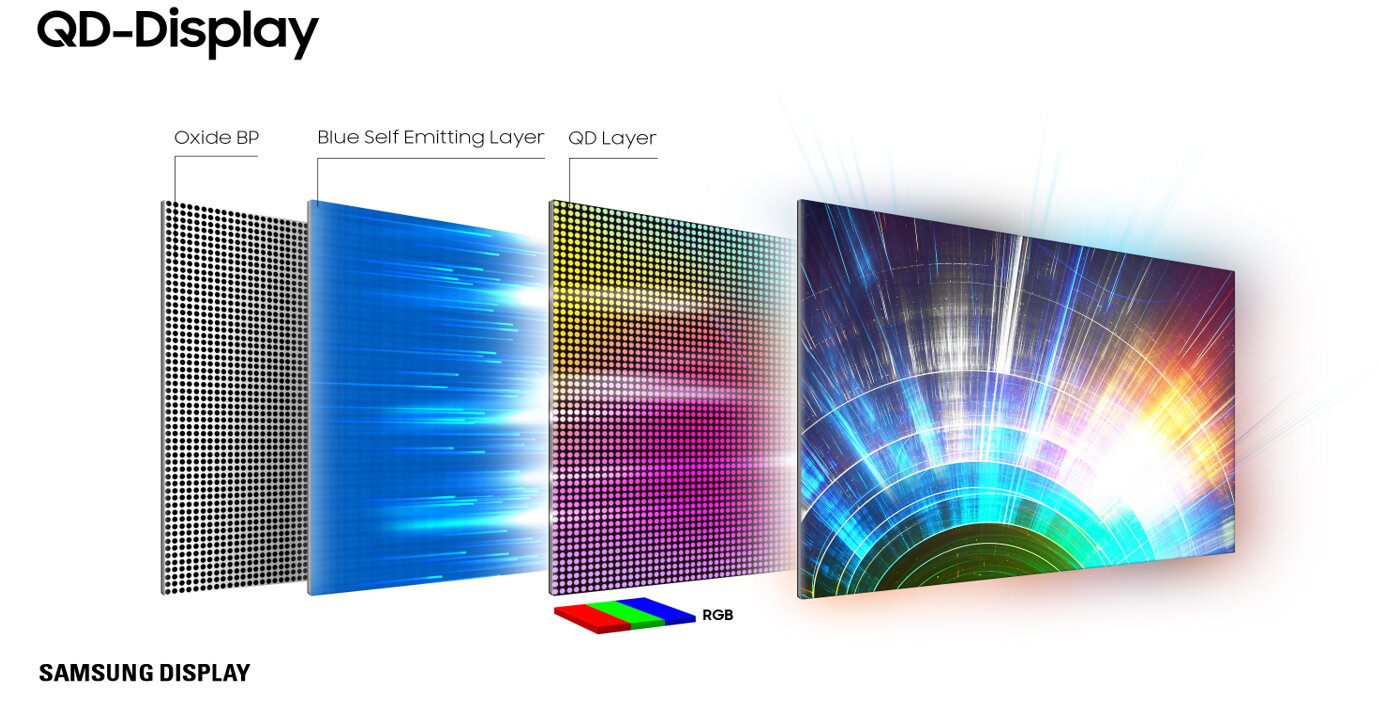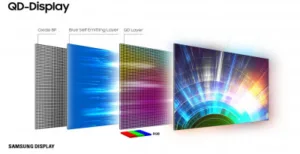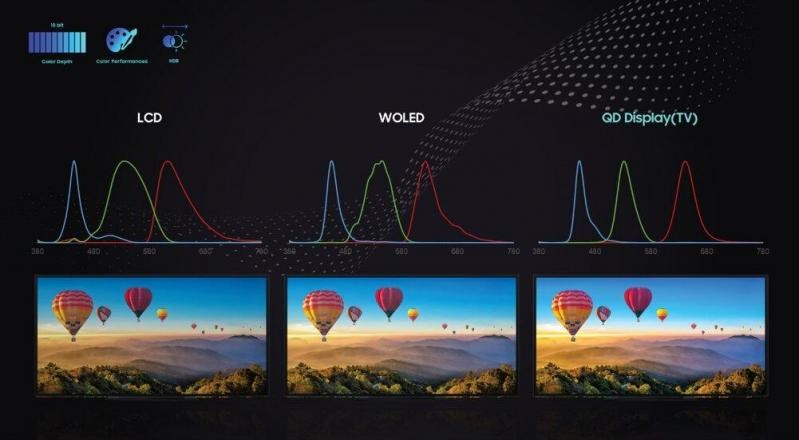New display technology QD-OLED, combination of Quantum Dot and OLED was demonstrated for the first time at CES 2022 by Samsung Display. This technology and the products have received the most attention including innovation awards.

It has also started the beginning of the use of QD-OLED display for TVs and monitors and will contribute to the growth and expanded presence of Quantum Dot (QD) technology. QD is enhancing LCD, OLED and MicroLED displays and is progressing towards next generation self-emissive display.
Sony announced the launch of the first QD-OLED consumer TV in 55” and 65” sizes. Samsung is also expected to bring in a QD-OLED TV this year. Dell Alienware and Samsung are also adopting 34″ QD-OLED for monitors. At CES, Samsung, LG, TCL and other brands showcased products that are continuing to push the envelope in terms of screen size and performance for TV, monitor, notebooks and other applications based on OLED, MiniLED, MicroLED and LCD technology.
QD-OLED: Bringing in Higher Display Performance
According to Samsung Display, QD-Display (QD-OLED) combines the best in material engineering, quantum physics and vision science to create stunning color, dazzling details and a thrilling experience. This is the world’s first display to integrate printed Quantum Dots with blue self-emitting pixels. The company is introducing QD-Display for the home entertainment market in two TV sizes, 55” and 65”, along with a 34” curved gaming monitor. It has red and green QD material printed on each pixel. QD-Display can provide superior color performance as it does not rely on color filters like WOLED or LCD.
 Samsung Display has highlighted some of the performance advantages of QD-Display.
Samsung Display has highlighted some of the performance advantages of QD-Display.
- Exceptional color performance (narrow band primary color emission provides, 90% BT2020, 99% DCI-P3)
- Full width at half maximum (FWHM) is 20 to 40 nanometers (nm) wide, about 10 to 20 nanometer narrower than that of other self-emitting displays. The slim spectral cones help to achieve an exceptional degree of color purity. The display also provides higher color volume.
- Lowest measurable black level of 0.0005 cd/m², achieving a true black.
- Uses true RGB additive light to create ‘perfect whites’ and high luminosity, providing extended HDR experience with an infinite contrast ratio.
- Superior XCR (experienced color range) almost 1.6x wider than contemporary displays
- Perfect black level as it can individually turn off each pixel, but controls local dimming at a sub-pixel level, enabling deeper blacks
- No halo, as millions of self-emitting pixels can adjust over all luminance with pinpoint accuracy. A brightly lit pixel can be next to a black pixel, thereby producing sharp character edges for images as well as subtitles
- One of the lowest levels of potentially harmful blue light, typically 40 to 50% less than LCD. The blue light of the QD-Display’s self–emitted light layer is fine-tuned to minimize the wavelengths in the harmful blue-light zone.
- Enables a wider viewing angle due to dome-shaped flux structure and it is also a top-layer emission display. Display also has low reflection.
- Provides an almost instantaneous native (GtoG) response time of 0.1ms. Because of its faster response time, QD-Display is able to re-create motion with significantly less blur.
Both Samsung Electronics and Dell Alienware have announced new gaming monitor using a 34″ curved QD-OLED display. Alienware’s 34″ gaming monitor comes in ultra wide format, 3440 x 1440 with 0.1ms GtoG response time and 175Hz refresh rates. It supports Nvidia G-Sync and is DisplayHDR 400 true black certified. Both Samsung and Dell Alienware gaming monitors received CES innovation awards. With higher display performance QD-Display (QD-OLED) curved gaming monitor expects to provide more immersive experience.
Sony announced the master series XR A95K TV, the first TV using Samsung Display’s QD-OLED panel, with Cognitive Processor XR and XR Triluminous. The 4K TV will come in 65” and 55”. Samsung Display is the only company so far to manufacture QD-OLED display panel and it can sell to multiple brands.
OLED- Pushing the Envelope in Size and Form factors
LG Display(LGD) showcased OLED.EX, the next generation OLED TV technology intended to provide an upgraded viewing experience; it also virtually showed transparent and flexible OLED solutions, gaming OLED display and 17-inch foldable OLED for laptops. OLED.EX display implements LGD’s Deuterium and personalized algorithm-based “EX technology”. Compared to conventional OLED display, brightness is boosted by 3% while bezel width is reduced by 30% from 6mm to 4mm based on a 65″ OLED display. LGD will integrate OLED.EX technology into OLED TV display starting from 2Q 2022 and will bring 42 and 48-inch OLED gaming displays to market in 2022.
OLED TVs have achieved leadership position in the premium TV market due to display performance and thinner form factors. According to LG Electronics, their OLED TVs have been CES innovation awards honoree for 8 consecutive years. The company highlighted these OLED TV display performance parameters and features.
- OLED TV employs self lighting pixels that turn on and off individually to deliver perfect blacks, incredibly natural colors and infinite contrast
- Backlight free, OLED is thinner, lighter than other display technology, enabling unprecedented form factors such as bendable and rollable TV.
- A new G2 model from LGE features LGD’s advanced OLED panel. OLED EVO technology (both in C1 and G1 series) delivers higher brightness for ‘ultra realistic’ images with superior clarity and details
- Powered by LG’s new a (Alpha)9 Gen5 intelligent processor, its brightness booster technology is said to deliver even more brightness through improved heat dissipation and more advanced algorithm.
- A new 83-inch model was introduced to the G2 series and the world’s first 97″ OLED model to complement the 55”, 65” and 77” TV line-up.
- LGD introduced the world’s first 42″ OLED TV, ideal for console or PC gaming
- Panels in the 2022 line-up have been certified for 100% color fidelity and 100% color volume. All 2022 LG OLEDs are certified as ‘flicker free’
- LG’s OLED panels have been recognized for their low blue light performance and meet Eyesafe low blue emission requirements
- Supports Nvidia G-Sync and its 8K OLED TV demonstrated 8K gaming with Nvidia GeForce (1ms response time)
Sony, Panasonic and many others are already selling a full range of OLED TVs.
Asus introduced the world’s first 17.3″ foldable OLED laptop at CES. In clamshell format it can be opened like a hard book to form a single 17.3” 4:3 aspect ratio (2560 x 1920) display like a tablet. The second option is to open like a laptop with two 12.5” 3:2 aspect ratio (1920 x 1280).
MiniLED: Getting Thinner and Better in Performance
TCL won the CES innovation award for its QD zero MiniLED 8K TV. It introduced the world’s first miniLED TV in North America. This third generation miniLED XL 85” 8K QLED TV featuring OD zero has an ultrathin profile of less than 3.4 mm. TCL is also focusing on wide color standard, more contrast with Contrast Control Zones, and more clarity with new HDR standards. It is also partnering with Pixelworks and others to define and deploy new motion ecosystem called TrueCut Motion. TCL also announced its 98” QLED TV priced at under $8K.
Sony introduced its first miniLED models including 8K resolution and powered by Sony’s Cognitive Processor XR, and XR Backlight Master drive for ‘more dazzling lights and deeper black with precise control’ by the miniLED backlight.
LG Electronics also unveiled its expanded QNED miniLED TV lineup with its own QD Nanocell technology with 100% color volume and ‘great contrast’ with dimming technology. Samsung showcased all its new technology that will be appearing on its Neo QLED miniLED TVs: Neo Quantum Processor (advance contrast mapping), shape adaptive light control (better control of blooming and an upgrade to a 14 bit backlight). The 2022 NeoQLED models will use a new Eye Comfort mode (automatically adjust the screen brightness, and tone based on built-in light sensor to reduce blue light levels).
MiniLED based displays have been introduced by top consumer brands such as Samsung, LGE, TCL, Apple and others for TV, monitor, notebooks and tablets. By the use of multi zone blinking backlights, miniLED with QD can enable LCD to have higher brightness, very high contrast, excellent HDR, thin form-factor, superior power efficiency and display performance close to OLED.
MicroLED: Focusing on Super Size TVs and Wearables
Samsung Electronics announced the latest versions of its microLED TVs at CES in 110”, 101” and in 89”. According to the company it offers best in class picture quality due to 25 million micrometer sized LEDs that individually produce light and colors and heightened level of clarity and contrast. The 2022 MicroLED TVs support 20 bit greyscale depth, delivering a ‘true HDR experience’, 100% of DCI-P3 and AdobeRGB color gamut and immersive design with 99.99% screen to body ratio.
TCL announced Leiniao AR, industry’s first binocular full color Micro-LED display powered by holographic optical waveguide technology in a pair of thin and light smart glasses.
Implication: Display Technology Innovations drive Product Innovations
Display Technology innovations are contributing to design and product innovations in the consumer market. It is leading to a broader spectrum of product availability for each application market with different features at different price points. This will also enable the co-existence of multiple display technologies. The introduction of a new display technology in QD-OLED will compete with OLED and MiniLED QD products in the premium market. With limited production capacity and higher costs it will serve initially in the premium niche market. (SD)
Sweta Dash, President, Dash-Insights
Sweta Dash is the founding president of Dash-Insights, a market research and consulting company specializing in the display industry. For more information, contact [email protected] or visit www.dash-insights.com


